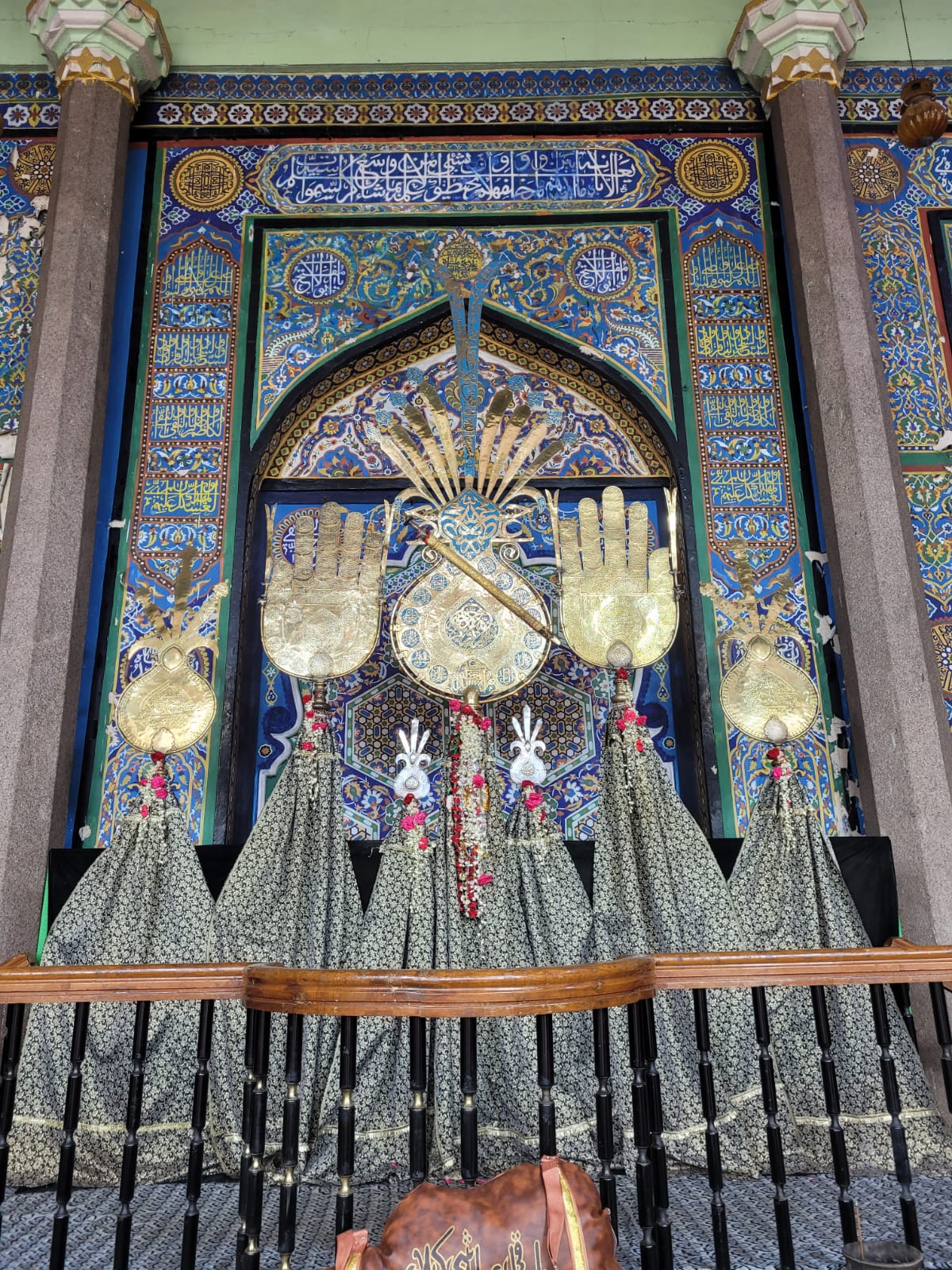Hyderabad: With the sighting of the new crescent moon on Saturday night, the beginning of the new lunar calendar year – 1444 Hijri – set in. With it, the first month of the Islamic calendar – Muharram – began here on Sunday. Members of the Shia Muslim community in Hyderabad, especially in the Old City, spruced up ancient and modern Ashurkhanas (places of mourning), where processions will take place in nine days.
There are about 140 big and small Ashurkhanas in Hyderabad, where Alams (battle standards from the battle of Karbala in which Imam Hussain, the grandson of Prophet Mohammed, was killed) are installed during Muharram.
What is an Ashurkhana?
An Ashurkhana is where Shia Muslims mourn during Ashura, the 10th of Muharram. The place is dedicated to Imam Hussain, a grandson of prophet Mohammed who was killed in the battle of Karbala (Iraq). Hussain was the son of Imam Ali, the prophet’s son-in-law (and cousin). Shia Muslims are followers of his. Hyderabad was founded by the Shia Muslim Qutub Shahi dynasty. Hence the high number of Ashurkhanas.
Places like the Badshahi Ashurkhanas, Imambara at Yakutpura, Ashurkhana Hazrat-e-Abbas, Azakhana e Zehra, Bibi ka Alawa and others draw a huge number of people during the first 10 days of Muharram. On the day that Imam Hussain died in 680 AD, a large number of public processions are taken out in Hyderabad every year to mark his martyrdom by Shia Muslims. In the preceding nine days, the community in Hyderabad conducts daily meetings, and others also visit Ashurkhanas around town.
Alams across Hyderabad
Members of the Shia Muslim community in Hyderabad, which are about three lakh in total, install Muharram Alams in their homes also, in tune with an ancient tradition. In fact, the founding dynasty of Hyderabad, the Golconda or Qutb Shahi dynasty, also installed Alams in Ashurkhanas across Telangana and appointed Hindus to take care of those places.
Known as ‘Peerula Pandaga’ in Telugu, many Hindus across Telangana also observe Muharram with Shias in Hyderabad and the state.
Mujtaba, a member of the community explained that the installation of Alams at homes in Hyderabad is an ancestral practice. “Not many people from other communities are aware of it. Alams are installed in about 50 percent of all Shia households. The standards may be made of silver, aluminium, copper, or even gold. A clean spot within the house is chosen for the installation of an Alam in Muharram,” he added.
In fact, moving with changing times, apartment buildings in the Shia-dominant areas of Hyderabad now make space for Muharram and Ashurkhanas. Buildings in areas like Darulshifa, Mir Alam Mandi and Noor Khan Bazaar have also begun providing large halls for the installation of Alams and for religious congregations.
How Muharram is observed
A little-known fact about the Muharram month is that during the first fortnight of the holy month, Shia Muslims mostly prefer to have simple vegetarian food. Non-veg is strictly prohibited. A Shia leader from Hyderabad, Hameed Hussain Jaffery, said it is a month of mourning for Muslims.
Another of the historic Ashurkhanas in Hyderabad is the Bibi Ka Alava in Hyderabad, which was set up during the Golconda or Qutb Shahi period (1518-1687). Known as Bibi ka Alam, it was set up by Hayat Bakshi Begum, the daughter of Hyderabad’s founder and wife of Sultan Mohammed Qutb Shah (fifth Golconda king).
Later during the Nizam era (1724-1948) in Hyderabad, the Bibi Ka Alam was shifted to its current place at Dabeerpura, specially built for the purpose of Muharram. The standard there contains a piece of the wooden plank on which Bibi Fatima was given her final ablution before burial. The relic is believed to have reached Golconda all the way from Karbala in Iraq during the reign of the sixth Golconda king, Abdullah Qutb Shah (1626-1672).
The Alam in that Ashurkhana also is said to have six diamonds and other jewels donated by the last Nizam of Hyderabad, Mir Osman Ali Khan. The jewellery is kept in six black pouches and tied to the standard. The Alam is carried on a caparisoned elephant on ‘Yaum-e-Ashura’, the 10th day of Muharram. It is followed by a procession with thousands of barefoot and bare-chested mourners from around 50 ‘anjumans’ (groups).
Badshahi Ashurkhana – second oldest monument in Hyderabad.
The Badshahi Ashurkhana was constructed between 1592-96, sometime after the Charminar was built in 1591. It is very special, as it was built by Hyderabad’s founder Mohd Quli Qutb Shah after he built the Charminar first to mark the new city of Hyderabad in 1591. After the Golconda dynasty ended in 1687 in the last war with the Mughals the place saw bad days for nearly a century.
It was briefly converted into a bandi khana or jail in 1764 after the Mughal emperor Aurangzeb conquered the kingdom of Hyderabad. And it wasn’t until Nizam Ali (the second monarch of the Asaf Jahi dynasty) came to power that the Badshahi Ashurkhana was given an annual grant.
The structure consists of the main Ashurhkhana, the Naqqar Khana (where ceremonial drums and shenai are played), the Niyaz Khana (food court), Sarai Khana (rest house), Abdar Khana (place to store water), the chabutra (platform) and a guard room. Close to 2,000 people attend every Thursday and in the month of Muharram with around 10,000 people visiting every day to attend the majlis (congregations).







